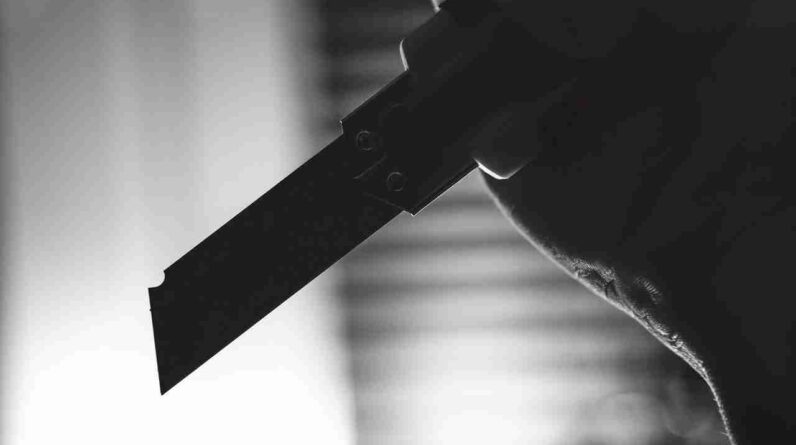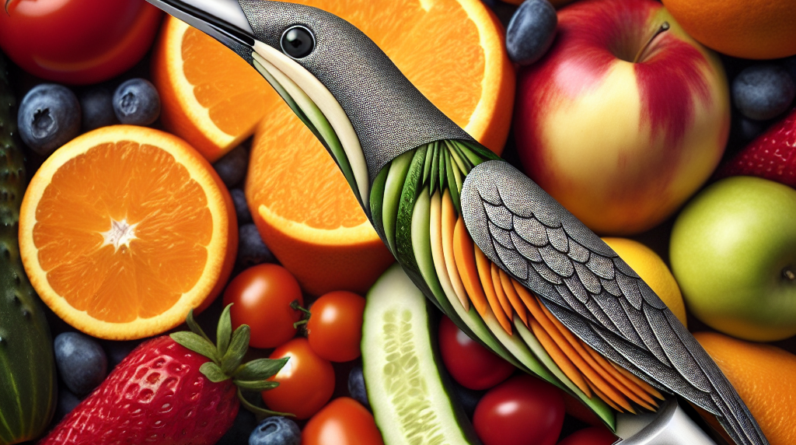Let’s talk about the art of slicing vegetables and finding the perfect knife for the job. We all know that a good knife can make the task a breeze, but with so many options available, how do we choose the right one? Whether you’re a seasoned chef or a beginner in the kitchen, we’ve got you covered. In this article, we’ll explore the key factors to consider when selecting a knife for slicing vegetables, ensuring that your culinary endeavors are as smooth and effortless as possible. So, buckle up and get ready to slice and dice your way to vegetable perfection!

1. Types of knives for slicing vegetables
When it comes to slicing vegetables, there is a wide variety of knives to choose from. Each type of knife is designed with specific features and characteristics to accommodate different slicing needs. Let’s explore some of the most commonly used knives for vegetable slicing:
1.1 Chef’s knife
A chef’s knife is a versatile knife that can handle a wide range of tasks, including slicing vegetables. It typically has a broad blade, ranging from 6 to 12 inches in length, with a curved edge that allows for efficient rocking motion during slicing. The chef’s knife offers excellent control and precision while slicing vegetables of various sizes.
1.2 Santoku knife
Originating from Japan, the Santoku knife is another popular choice for vegetable slicing. It features a shorter and wider blade compared to a chef’s knife, typically ranging from 5 to 7 inches in length. The Santoku knife has a flat edge and a more forward cutting motion. Its blade design allows for thin, precise slices and is particularly effective for chopping and dicing vegetables.
1.3 Utility knife
As its name suggests, the utility knife is a versatile tool suitable for a wide range of tasks, including slicing vegetables. It typically has a narrower and shorter blade, ranging from 4 to 7 inches in length, with a plain or serrated edge. The utility knife is handy for tasks that require more control and precision, such as trimming and slicing smaller vegetables or intricate cutting tasks.
1.4 Paring knife
Paring knives are small, delicate knives with a thin, narrow blade ranging from 2 to 4 inches in length. They are ideal for intricate tasks that require finesse, such as peeling and trimming vegetables. While not the primary choice for slicing larger vegetables, a paring knife can still be useful for certain slicing tasks that require precision and dexterity.
1.5 Nakiri knife
The Nakiri knife is a Japanese-style knife specifically designed for vegetable preparation. It features a straight and thin blade, ranging from 6 to 7 inches in length, with a squared-off tip. The flat edge of the Nakiri knife allows for precise, clean cuts, making it an excellent choice for slicing vegetables in a downward chopping motion.
1.6 Serrated knife
Serrated knives feature a blade with small, saw-like teeth along the edge. These teeth help grip and cut through tough exteriors, making them ideal for slicing vegetables with a tough skin, such as tomatoes or peppers. Serrated knives are also useful for slicing through crusty bread and delicate pastries.
1.7 Cleaver
The cleaver is a heavy, thick-bladed knife designed for heavy-duty tasks, such as splitting bones and chopping through dense vegetables. While not commonly used for slicing vegetables, a cleaver can be handy for tasks like separating large squash or cutting through hard root vegetables.
1.8 Mandoline slicer
Although not precisely a knife, a mandoline slicer is a useful tool for slicing vegetables. It consists of a flat surface with an adjustable blade that allows for consistent, thin slices. Mandoline slicers are particularly effective when slicing vegetables like cucumbers, carrots, and potatoes into even, uniform slices.
1.9 Electric knife
For those who prefer a more effortless slicing experience, an electric knife can be a great option. These knives feature motorized blades that rapidly move back and forth, allowing for effortless slicing of vegetables. Electric knives are especially useful for slicing large quantities of vegetables quickly and evenly.
1.10 Ceramic knife
Ceramic knives are known for their exceptional sharpness and lightweight design. They have a hard, non-reactive blade made from ceramic material. While not as versatile as other types of knives, ceramic knives excel in precision slicing tasks and are particularly useful for slicing delicate vegetables like tomatoes without crushing them.
Now that we’ve explored the various types of knives available for slicing vegetables let’s move on to some important considerations to keep in mind when choosing the right knife.
2. Considerations when choosing a knife
Choosing the right knife for slicing vegetables involves considering several factors that can greatly impact your slicing experience. Here are some key factors to keep in mind when selecting a knife:
2.1 Blade material
The material of the blade plays a significant role in the knife’s performance and durability. Stainless steel blades are known for their resistance to corrosion and ease of maintenance. High-carbon stainless steel blades offer excellent sharpness and edge retention. Ceramic blades, on the other hand, provide superior sharpness but are more prone to chipping.
2.2 Blade length
The length of the blade determines the knife’s versatility and its ability to handle different slicing tasks. Longer blades, such as those found in chef’s knives, offer more surface area for slicing larger vegetables, while shorter blades like paring knives are better suited for precision tasks.
2.3 Handle material
The handle material affects the knife’s comfort and grip. Common handle materials include wood, plastic, and composite materials. Each material offers different levels of grip and durability, so it’s important to choose one that feels comfortable and secure in your hand.
2.4 Knife weight
The weight of the knife can greatly impact your slicing experience. Lighter knives are easier to control and maneuver, making them suitable for delicate slicing tasks. Heavier knives, on the other hand, offer more power and stability for slicing through denser vegetables.
2.5 Knife balance
The balance of the knife refers to how the weight is distributed between the blade and the handle. A well-balanced knife ensures optimal control and reduces fatigue during prolonged slicing tasks. It’s important to find a knife that feels balanced and comfortable in your hand.
2.6 Blade shape
Different blade shapes are designed for specific slicing techniques. Straight blades are versatile and can handle a variety of slicing tasks, while curved blades are ideal for chopping and rocking motions. Consider the types of slicing techniques you often use and choose a blade shape that complements your preferred slicing style.
2.7 Sharpness
The sharpness of the blade is essential for achieving clean, effortless slices. Look for knives with a reputation for excellent sharpness and edge retention. Keep in mind that even the sharpest knives will require regular sharpening and maintenance to maintain their performance.
2.8 Durability
A durable knife is built to withstand repeated use and maintain its performance over time. Consider the quality of materials used in the knife’s construction, such as the blade material, handle material, and overall craftsmanship. A well-made knife will offer durability and longevity.
2.9 Maintenance
Proper maintenance is crucial to keep your knife in optimal condition. Some knives require more maintenance than others, such as regular sharpening or oiling. Consider your willingness and ability to perform necessary maintenance tasks when choosing a knife.
2.10 Budget
Lastly, your budget will play a role in determining the knife you ultimately choose. Knives come in a wide range of price points, and it’s important to find a balance between quality and affordability. Set a budget that fits your needs and aims to find the best knife within that range.
Now that we’ve explored the considerations when choosing a knife, let’s move on to how you can choose the right knife for your specific needs.
3. Choosing the right knife for your needs
Choosing the right knife for slicing vegetables involves understanding your slicing needs and evaluating your knife preferences. Here are some steps to help you find the perfect knife for you:
3.1 Assessing your slicing needs
Start by considering the types of vegetables you most commonly slice and the slicing techniques you use. Do you frequently slice large, dense vegetables like pumpkins and butternut squash? Are you often working with delicate vegetables like tomatoes or herbs? Understanding your specific slicing needs will help narrow down the type of knife that will best suit your requirements.
3.2 Evaluating your knife preferences
Consider your personal preferences when it comes to knives. Do you prefer a certain weight or handle material? Do you prefer a specific blade shape or length? Evaluating your preferences will help guide your decision-making process and ensure that the knife you choose feels comfortable and intuitive to use.
3.3 Trying out different knives
One of the best ways to determine the right knife for you is to try out different knives in person. Visit a kitchenware store or a specialty knife shop where you can handle and test various knives. Pay attention to how each knife feels in your hand, its weight, balance, and overall comfort. Trying out different knives will give you a firsthand experience of what works best for you.
3.4 Considering ergonomic factors
Ergonomics plays a crucial role in the comfort and safety of using a knife. Look for knives with ergonomic handles that fit comfortably in your hand and provide a secure grip. Consider the shape of the handle and the spacing of the handle from the blade to ensure optimal control and minimize fatigue during prolonged use.
3.5 Seeking advice from professionals
If you’re still unsure about which knife to choose, consider seeking advice from professionals in the culinary industry. Chefs, professional knife sharpeners, or knowledgeable salespeople can provide valuable insights and recommendations based on their expertise. Their expertise can help steer you towards the right knife for your needs.
4. Additional features to look for
In addition to the basic factors discussed earlier, there are several additional features or characteristics to consider when choosing a knife for slicing vegetables. These features can enhance your slicing experience and provide added functionality:
4.1 Full tang construction
A full tang construction means that the blade extends the full length of the knife and is secured by the handle. Knives with full tang construction offer better balance, strength, and durability compared to knives with partial tang or rat-tail tang construction.
4.2 Bolster
The bolster is the thickened area between the blade and the handle. A well-designed bolster provides balance and serves as a finger guard, protecting your hand from accidentally sliding onto the blade. Look for knives with a sturdy, well-integrated bolster for added safety and stability.
4.3 Serrated edge
While primarily associated with bread knives, some knives designed for vegetable slicing may feature a serrated edge. A serrated edge can be useful for slicing through vegetables with tough or fibrous exteriors, such as tomatoes or peppers. Consider whether a serrated edge would be beneficial for your specific slicing needs.
4.4 Granton edge
A granton edge refers to a series of shallow, oval-shaped hollows or divots on the blade’s side. These hollows reduce friction during slicing by creating air pockets, preventing food from sticking to the blade. Knives with a granton edge can be particularly useful when slicing vegetables with a high water content, such as cucumbers or watermelons.
4.5 Non-stick coating
Some knives come with a non-stick coating applied to the blade. This coating helps reduce friction and prevents food from sticking to the blade. Non-stick coatings are beneficial when working with sticky or moist vegetables and can make cleaning the knife easier.
4.6 Blade flexibility
The flexibility of the blade can impact its ability to maneuver around curves and contours of vegetables. While stiffer blades offer more stability and control, flexible blades can be advantageous for certain slicing techniques and delicate vegetables. Consider the level of flexibility that would be most suitable for your specific slicing needs.
4.7 Blade thickness
The thickness of the blade can affect its performance and versatility. Thicker blades offer more durability and can handle heavier slicing tasks, while thinner blades excel at precision slicing. Consider the types of vegetables you frequently slice and choose a blade thickness that aligns with your slicing needs.
4.8 Length of serrations
If you opt for a knife with a serrated edge, consider the length and depth of the serrations. Deeper serrations may provide better grip on tough exteriors, while shorter serrations are more suitable for delicate slicing tasks. Assess your specific slicing needs and choose a serration length that best accommodates those needs.
4.9 Handle design
In addition to the handle material, the design of the handle itself is an important factor to consider. Look for handles that are comfortable, secure, and allow for a natural grip. Ergonomic handles with textured grips can enhance control and minimize hand fatigue during slicing tasks.
4.10 Warranty
Considering the warranty offered by the knife manufacturer can provide peace of mind. A reliable warranty ensures that the manufacturer stands behind the quality and craftsmanship of their product. Look for knives with a generous warranty that covers any potential defects or issues that may arise.

5. Knife care and maintenance
Once you have chosen the perfect knife for slicing vegetables, proper care and maintenance are essential to ensure its longevity and performance. Here are some fundamental practices for caring for your knife:
5.1 Regular sharpening
Maintaining a sharp edge is crucial for efficient slicing. Regularly sharpening your knife ensures that it maintains optimal sharpness. Use a sharpening stone or a honing rod to maintain the blade’s edge. If you’re not confident in sharpening the knife yourself, consider seeking professional knife sharpening services.
5.2 Proper storage
Storing your knife properly prevents accidents and maintains its condition. Consider using knife guards or investing in a knife block or magnetic strip to securely store your knives. Avoid storing knives in a cluttered drawer where they can rub against other utensils and potentially dull the blade.
5.3 Hand washing
Avoiding the dishwasher and hand-washing your knife is crucial for its longevity. Hand washing allows you to control the water temperature, avoid exposure to harsh detergents, and prevent unnecessary wear and tear caused by the dishwasher’s agitation.
5.4 Avoiding dishwasher
Dishwashers can expose knives to harsh detergents and high heat, which can deteriorate the blade’s edge and potentially damage the handle. Hand washing your knife is the best way to maintain its performance and condition.
5.5 Oil the blade (if necessary)
Some knives, particularly those with carbon steel blades, may benefit from occasional oiling to maintain their condition. Applying a thin layer of food-grade mineral oil can help protect the blade from rusting and maintain its appearance.
5.6 Repairing and maintenance services
If your knife requires repairs or maintenance beyond your capabilities, consider seeking professional knife repair and maintenance services. These professionals can help restore damaged blades, tighten loose handles, or perform any necessary repairs to keep your knife in optimal condition.
5.7 Safe handling and usage
Practicing safe handling and usage is essential to prevent accidents and maintain the knife’s condition. Always use a cutting board when slicing to protect both the knife and your countertop. Avoid using excessive force or applying sideways pressure, as this can damage the blade. Remember to keep your fingers away from the blade and exercise caution while slicing.
5.8 Keeping knives dry
Properly drying your knife after washing is vital to prevent rust and corrosion. Use a kitchen towel or a microfiber cloth to thoroughly dry the blade and handle. Avoid leaving the knife wet or damp for an extended period.
5.9 Avoiding hard cutting surfaces
Resist the temptation to cut on hard surfaces like granite or ceramic plates, as these can damage the knife’s edge. Stick to softer cutting surfaces like wooden or plastic cutting boards to maintain the blade’s sharpness and integrity.
5.10 Routine inspection
Regularly inspect your knife for any signs of damage or wear. Look for chips or cracks in the blade, loose handles, or any other issues that may affect the knife’s performance. Promptly address any concerns or seek professional assistance if necessary.
By following these care and maintenance practices, you can ensure that your knife remains in excellent condition and continues to meet your slicing needs for years to come.
In conclusion, choosing the right knife for slicing vegetables involves considering the different types of knives available, understanding the factors to consider when making a choice, evaluating your individual slicing needs and preferences, and keeping in mind additional features that can enhance your slicing experience. With proper care and maintenance, your chosen knife will be a reliable companion in your culinary adventures, making vegetable slicing a breeze. Happy slicing!









